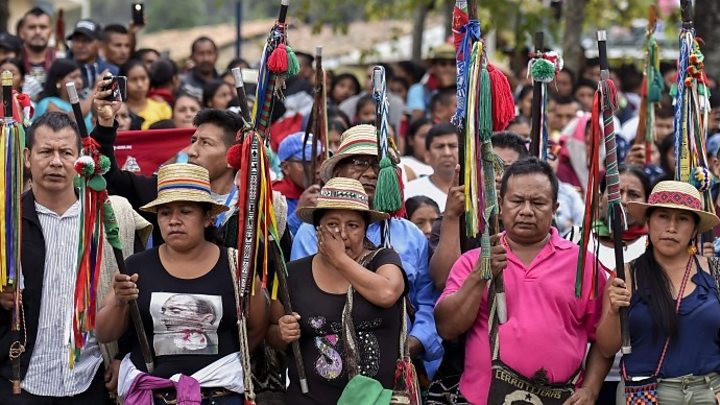Home » Latin America »
Colombia dissident rebels kill indigenous leader
An indigenous leader, Cristina Bautista, and four volunteer community guards have been killed in south-west Colombia.
The security forces say that members of a dissident rebel group are behind the attack in Cauca province.
The number of indigenous Colombians killed has risen steeply amid a resurgence of violence by dissident rebel groups and paramilitaries.
President Iván Duque has sent the interior minister to the area.
He also said that he had ordered the military to “find the criminal group responsible for the attack”.
What happened?
According to the local indigenous council, members of the Nasa indigenous guard tried to stop a car as part of routine checks on Tuesday afternoon.
Inside the vehicle was reportedly the leader of a dissident rebel group along with two of his men, who demanded they be let through.
A stand-off ensued with the indigenous guard raising the alarm, prompting more locals to gather.
The rebels opened fire killing four members of the guard and Cristina Bautista, the indigenous governor of the area. Six others were injured.
An ambulance carrying the injured was shot at and more dissident rebels rushed to the scene to try and “spring” those stopped by the indigenous guard, according to a statement by the council.
The Colombian army has confirmed that a breakaway group from the Farc rebel group was behind the attack.
They said all dissident rebels involved had managed to escape.
Who are the Nasa?
The Nasa are an indigenous group which lives in Cauca province, in the mountainous south-west of Colombia.
Many of them live on land which they themselves administer, patrol and govern.
They have their own indigenous guard which is made up of volunteers. The guard describes itself as less than a police force and more as mediators who do not carry arms but only wooden staffs adorned with the red and green colours of the Nasa.
What’s behind the clash?
Many of the Nasa live in areas where Marxist Farc rebels used to be active.
The Farc rebel group signed a peace agreement with the Colombian government in 2016 and ordered its fighters to lay down arms. But not all the Farc rebels agreed with their leadership’s strategy and some broke away to continue fighting the state and engaging in criminal activities, such as drug trafficking and extortion.
As the dissident rebels try to expand the territory they control they increasingly clash with the indigenous guard protecting it.
Dozens of Nasa, many of them members of the guard, have been killed this year. The United Nations has urged the Colombian government to do more to protect its indigenous people.
In August, two members of the Nasa indigenous guard were shot dead when gunmen opened fire on the bus they were travelling in.
Source: Read Full Article




